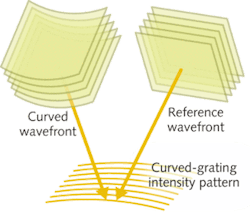SEMICONDUCTOR LASERS: Curved grating creates high-brightness surface-emitting DFB laser
A curved-grating resonator in a semiconductor quantum-well laser design is the basis for a high-brightness surface-emitting distributed-feedback (SE-DFB) laser developed by Alfalight (Madison, WI).1 Operating at 976 nm, the laser delivers more than 2 W of diffraction-limited power in continuous-wave (CW) operation. Record output power of 73 W from a single emitter has also been demonstrated.
Compared to edge-emitting laser diodes, surface-emitting diodes offer reduced manufacturing costs: critical edge-facet cleaving is replaced by noncritical chip dicing; microchannel coolers are replaced by ultracheap copper blocks; critical die alignment to the knife-edge of a heat sink is replaced by noncritical alignment; and post-bar-fabrication coating and testing requirements are replaced by wafer-level coating and probing, respectively.
The key attributes of the SE-DFB laser–superior spectral and spatial brightness—are achieved by monolithic chip-level integration of a curved grating in an unstable resonator configuration. The metal-on-semiconductor diffraction grating resides on the p-side surface of the laser. Its second-order diffraction provides wavelength-selective feedback and locks the output wavelength to narrow the emission bandwidth to less than 0.2 nm. In its first-order diffraction, the grating also acts as the output coupler, sending the laser light out the top of the device through an antireflection-coated output window created on the substrate surface. The SE-DFB laser is mounted p-side down on a heatsink.
The secret sauce
Unique to Alfalight’s SE-DFB device is the curved grating, fabricated holographically using the interference of a curved wavefront and a plane-wave reference wavefront (see figure). Due to curvature in the lateral wavefront, the laser beam appears to come from a narrower virtual line source behind the grating even though a large gain volume has been electrically pumped. Essentially, the curvature of the grating controls the beam size or brightness of the laser, while the area of the central pumped region determines the total output power. The rectangular perimeter area surrounding the central pumped region is an unpumped grating region that helps to extract maximum power out of the laser. The region outside this unpumped grating is an absorber region that helps to suppress any parasitic modes from coupling back into the laser.
In addition to the increase in brightness, the curved grating collimates the output beam in the longitudinal direction. As a result, SE-DFB lasers do not require the expensive and sensitive fast-axis collimation lenses that are required for edge-emitting diode lasers. These SE-DFB devices can be combined into two-dimensional arrays and coupled into a fiber using standard inexpensive cylindrical and spherical lenses, unlike laser-diode bars that require special (and expensive) optics to equalize the beam along both axes before focusing. An array of SE-DFB diodes arranged in a 4-6-6-4 circular pattern can produce power levels around 200 W, while two arrays interleaved in a 6-9-9-6 circular pattern can achieve nearly 300 W power levels.
The combination of high brightness, wavelength locking, and low-cost manufacturing makes SE-DFB arrays attractive for high-power fiber-laser pumping applications. Pump modules built using this technology stay tuned on the 976 nm absorption peak of ytterbium-doped fibers over a wide range of operating currents and temperatures, since the temperature shift of SE-DFB lasers is only 0.07 nm/°C (compared to around 0.3 nm/°C for nonstabilized edge-emitting lasers). “Because SE-DFB lasers have no facet, they are immune to catastrophic optical damage and very resistant to optical feedback,” says Manoj Kanskar, vice-president of R&D at Alfalight. “Access to such cheap, rugged, and bright laser sources will offset limitations of current bar-based technology.”
REFERENCE
- M. Kanskar et al., Photonics West 2009, OPTO conf. paper 7230-48, San Jose, CA (Jan. 29, 2009).

Gail Overton | Senior Editor (2004-2020)
Gail has more than 30 years of engineering, marketing, product management, and editorial experience in the photonics and optical communications industry. Before joining the staff at Laser Focus World in 2004, she held many product management and product marketing roles in the fiber-optics industry, most notably at Hughes (El Segundo, CA), GTE Labs (Waltham, MA), Corning (Corning, NY), Photon Kinetics (Beaverton, OR), and Newport Corporation (Irvine, CA). During her marketing career, Gail published articles in WDM Solutions and Sensors magazine and traveled internationally to conduct product and sales training. Gail received her BS degree in physics, with an emphasis in optics, from San Diego State University in San Diego, CA in May 1986.
